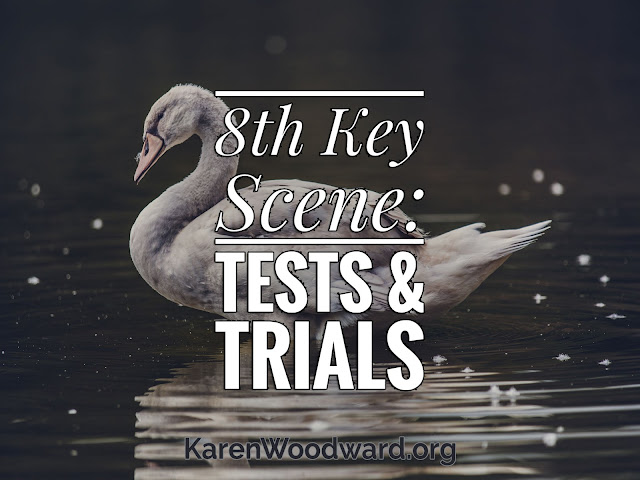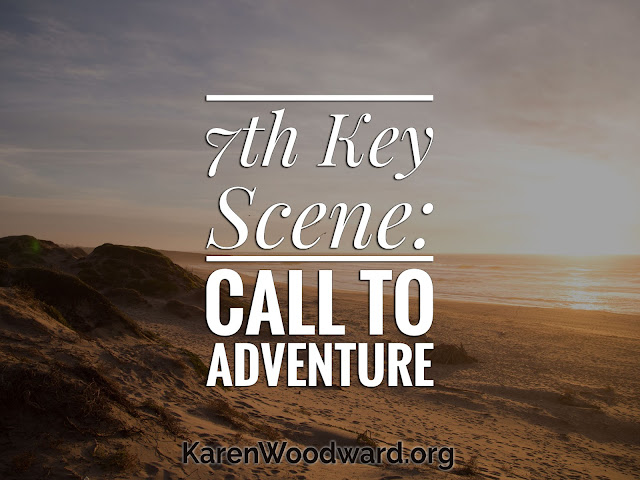“We are all apprentices in a craft where no one ever becomes a master.”
In honor of NaNoWriMo, every day this month I’m blogging about a key scene, one that any suspenseful story will include either implicitly or explicitly. I then take a close look at how this scene, this structure, is implemented in three popular genres: Action, Romance and Mystery. So far I've posted articles about the Inciting Incident, the Lock-In, Pinch Point One, the Midpoint Crisis, the All Hope is Lost point, and the Climax.
Today I'm going to talk about a scene (or sequence of scenes) often referred to as Tests and Trials.
Tests and Trials: Breaking It Down
After leaving the Ordinary World and entering the Special World of the Adventure, the protagonist goes through a series of Tests and Trials.
The Special World is radically different from the Ordinary World. Metaphorically, it’s inside out and upside down, Kansas vs the Land of Oz. In this new environment the protagonist is a fish out of water. She doesn't have any idea of the rules, the norms, that govern conduct in the Special World.
Part of being a fish out of water has to do with her strengths and weaknesses being flipped. Qualities that were strengths in the Ordinary World now become weaknesses and her weaknesses are now strengths. Think of Luke Skywalker in the Mos Eisley Cantina or Frodo and company in The Prancing Pony.
Many of the things we said of the Ordinary World are also true of the Special World. For instance, the protagonist will often meet new friends as well as make new enemies.
Though I’m not going to say much about it here, the B-Story often begins now and will involve new friends the protagonist makes in the Special World. To read more about A- and B-Stories I recommend Steven Pressfield’s article: The “A” Story and the “B” Story.
Another similarity between the Ordinary World and the Special World is that, on entering the Special World, the protagonist will have a clear initial goal, one that will soon take on new dimensions.
Tests and Trials, Fun and Games
As soon as the protagonist enters the Special World she will begin a series of Tests and Trials, mini adventures which highlight the strangeness of the Special World. Because her strengths are now weaknesses, and vice versa, she will fail quite a lot and in ways she couldn’t have foreseen.
As the protagonist goes through her Tests and Trials she’ll often receive aid and advice from her new friends and be hindered by her new enemies.
Tests and Trials are often also a time of Fun and Games, a time of bonding through adversity.
During this period it may seem as though the protagonist loses sight of her story goal, and that’s fine. It gives the audience a breather, perhaps they have a laugh or two. Here you have time and space to develop your characters and make your readers care about them.
Often, at the tail end of Tests and Trials the protagonist has her first big success. For the first time she triumphs over her tormentors. There’s a brief celebration then, suddenly, the Big Bad rears his head (this is the first Pinch Point—for more on this see here and here).
Key Points
- The protagonist is a fish out of water in the Special World. She doesn't know the rules.
- In the context of the Special World the protagonist’s strengths become weaknesses and perhaps her weaknesses become strengths.
- The protagonist has a well-defined goal going into the period of Tests and Trials.
- The protagonist makes new friends and gains new enemies.
Where is it?
The Tests and Trials part of the adventure comes at the beginning of the second act, about 25% to 35% of the way through the story.
How is it connected to the protagonist’s desires?
The Tests and Trials portion of the story should be connected to the protagonist’s internal and external desires, but there is a bit of wiggle room here. New elements are introduced into the story as the protagonist meets new characters and learns about their desires, their goals. One thing we need to show here is how the desires of the new characters mesh with those of the protagonist. Are they compatible? Incompatible?
This is an important part of character development and adds depth to the story.
Tests and Trials: Examples
In Edge of Tomorrow the Test and Trials portion of the story begins when Cage, drenched in the blood of an alpha, dies and wakes up in the previous day.
In the beginning Cage has no idea what’s happening. He’s put through tests and trials as, desperate, he tries to learn how to fight all the while keeping himself—and as many others as he can—alive. This sequence also has incredibly funny parts. There’s one scene that, even though I know it’s coming, I laugh out loud every time I see it. Cage is NOT a fighter by any stretch of the imagination—in the beginning of the story, he can’t figure out how to take the safety lock off his weapon!
Testing the Scene Example
Fish out of water. In the Ordinary World Cage creates propaganda. He’s good with words, with creating a narrative, but he couldn’t shoot a gun to save his life. Literally! He doesn't know the rules, the norms. Check.
Well defined goals going in. Cage’s goal is to NOT fight. Even when he’s on the beach in the midst of the battle he tries to run back to safety! But, as soon as he figures out that if he doesn’t learn how to fight that he will die, he begins to apply himself. So, yes. He has a well defined goal: survive.
Makes new friends and enemies. In Cage’s case he ignores the people who are hostile to him and makes friends with those who can help him. Check.
How the Midpoint is Implemented in Three Genres: Action, Romance & Mystery
Action Genre
I’ve covered the action genre, above.
Romance Genre
It depends on the kind of romance story you’re writing, but this is generally the “getting to know each other” phase that my male friends hate and my female friends (including moi) get all dreamy over.
Any romantic contact with the antagonist is forbidden (he’s a prince, she’s a pauper, etc.), and even if it wasn't forbidden the protagonist knows a relationship would never work. Never EVER. Still, the protagonist keeps thinking about the antagonist, she wants him to notice her. Then she does something mortifying and, sure enough, he notices her! He comes over and offers her a hand but she just wants the floor to open up and swallow her.
It turns out he likes her, he thinks she’s cute and different. Perhaps their essential incompatibility appeals to him because he’s not looking for a serious relationship.
And so on.
Murder Mystery Genre
In a murder mystery this is where the sleuth acquaints himself with the case by questioning suspects and investigating clues.
Every post I pick a book or audiobook I love and recommend it to my readers. This serves two purposes. I want to share what I’ve loved with you, and, if you click the link and buy anything over at Amazon within the next 24 hours, Amazon puts a few cents in my tip jar at no cost to you. So, if you click the link, thank you! If not, that’s okay too. I’m thrilled and honored you’ve visited my blog and read my post. :-)
Today I’d like to recommend one of my favorite Agatha Christie murder mysteries, Murder on the Links: A Hercule Poirot Mystery.
From the blurb: “An urgent cry for help brings Poirot to France. But he arrives too late to save his client, whose brutally stabbed body now lies face downwards in a shallow grave on a golf course. But why is the dead man wearing his son's overcoat? And who was the impassioned love-letter in the pocket for? Before Poirot can answer these questions, the case is turned upside down by the discovery of a second, identically murdered corpse . . ..”
That’s it for today! I’ll talk to you again tomorrow.
Word count so far: 12,755
Word count for today: 1,465
Total words this month: 14,220


